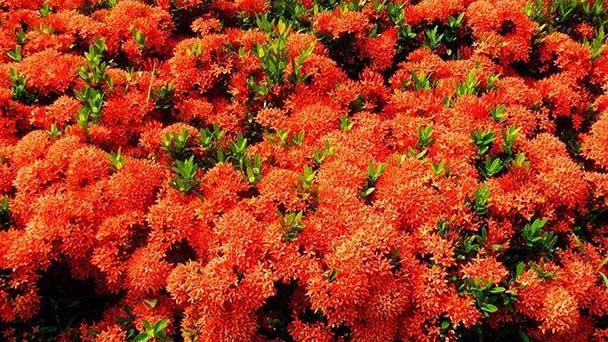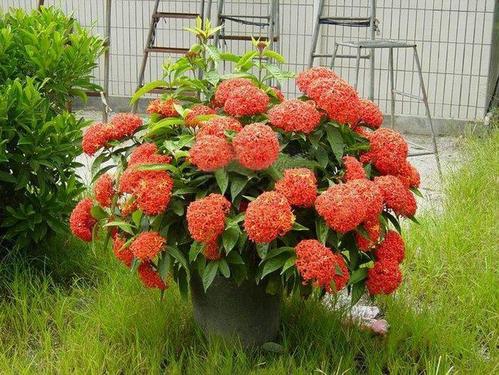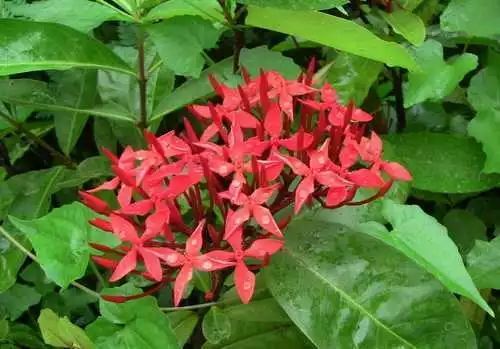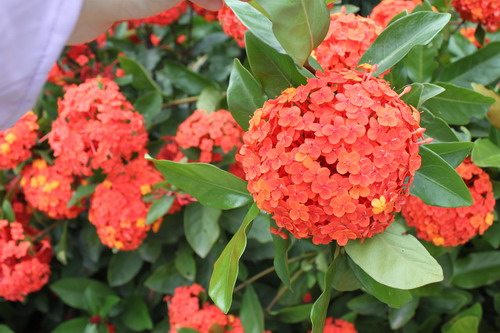Lxora chinensis Lam profile
Written by Maggie
Nov 16 2020

Lxora chinensis Lam is a plant belonging to the Rubiaceae family and the genus Dragonflower. The plants are low and short, the flowers and leaves are beautiful, and the flowers are rich in red, orange, yellow, white, and double colors. The plant of Lxora chinensis Lam is beautiful in shape, densely blooming, and rich in color. It is an important potted woody flower and the national flower of Myanmar. In southern Guangxi Province of China, people are used to calling it water hydrangea. Lxora chinensis Lam has a long flowering period, and can bloom from March to December every year.
Lxora chinensis Lam picture

Morphological characteristics of Lxora chinensis Lam
Lxora chinensis Lam is a shrub, 0.8-2 meters high, glabrous; the branchlets are dark brown and shiny at first, and gray with lines when they are old. The leaves are opposite, sometimes several into 4 whorls due to the extremely short internode distance, lanceolate, oblong-lanceolate to oblong-oblanceolate, 6-13 cm long, 3-4 cm wide, blunt or apex Round, short pointed or round at the base; midribs are flattened on the top and slightly concave, convex on the bottom, side veins are 7-8 on each side, slender, conspicuous, connected to each other near the leaf margin, transverse veins are loose and conspicuous; The petiole is very short and thick or absent; the stipules are 5-7 mm long, broad at the base, and connate into a sheath shape, the tip is long and acuminate, and the acuminate part is tapered, longer than the sheath. The inflorescence is terminal, multi-flowered, with a short total pedicel; the total pedicel is 5-15 mm long, and the branches are red, and it is rarely powdery pilose. The base often has 2 small leaves supporting; bracts and bracteoles Tiny, born in pairs at the base of the torus; flowers with pedicel or no; calyx tube 1.5-2 mm long, calyx eaves 4-lobed, lobes very short, 0.8 mm long, short pointed or obtuse; corolla red or reddish yellow, long in full bloom 2.5-3 cm, 4 lobed apex, lobes obovate or nearly round, extended or reversed, 5-7 mm long, 4-5 mm wide, blunt or round at the tip; filaments are extremely short, anthers are oblong, approximately in length 2 mm, 2-lobed at the base; style short protruding outside the crown tube, stigma 2, initially close together, diverging when blooming, slightly curved. The fruit is subglobose, twin, with a groove in the middle, red and black when mature; the seed is long and 4-4.5 mm wide, convex on the top and concave on the bottom. Flowering from May to July.
Lxora chinensis Lam growth habit
Temperature and light: Lxora chinensis Lam is more suitable for environments with high temperature and sufficient sunshine. It likes humid and hot climates and is not resistant to low temperatures. The optimum temperature for growth is 23~32℃. When the temperature is lower than 20℃, its growth is weakened and the flowering is obviously reduced. However, if the sunshine is sufficient, there will still be a certain number of flower buds; when the temperature is lower than 10℃, its physiological activity will decrease , Growth is slow; when the temperature is lower than 0 ℃, it will produce freezing damage.
Soil: Dragon Boat Flower likes acidic soil, the most suitable soil pH is 5 to 5.5. Soil with good drainage and good fertility retention can grow well. The best cultivation soil is sandy loam or humus loam rich in organic matter. If the soil is alkalescent, the growth of dragon boat flowers will be blocked and the growth will be poor.
Distribution of Lxora chinensis Lam
Lxora chinensis Lam is native to China, Myanmar and Malaysia. China is mainly distributed in Fujian, Guangdong, Hong Kong and Guangxi. There are also tropical areas such as Vietnam, the Philippines, Malaysia, and Indonesia.
Lxora chinensis Lam reproduction method
Lxora chinensis Lam can be propagated by sowing, layering, cuttings, but cuttings are generally used.
Cuttings
It is better to proceed from June to July. Select semi-mature branches of Lxora chinensis Lam, 10~15 cm long, and insert them into the sand bed at a suitable temperature of 24~30℃, and take roots 40~50 days after insertion. The cuttings are soaked in 0.5% indole butyric acid solution for 3 to 5 seconds to shorten the rooting period.

1. Environmental factors affecting the rooting of Lxora chinensis Lam
The suitable bed temperature for cutting Lxora chinensis Lam hair roots is 25~35℃, and the temperature is slightly lower than the bed temperature, about 23~35℃; cutting time is best in spring and summer. Under normal circumstances, natural light can basically satisfy cuttings hair roots. Yes, but during the tropical summer high temperature period, because the cuttings are prone to wilting, it is best to use spray seedlings, and the cuttings should be shading within a few days. The shading rate is gradually reduced from 50% to 60% at the beginning to 40% to 50%. After the hair roots, remove the shade.
2. Cutting of cuttings
The quality of cuttings not only affects the quality of Lxora chinensis Lam seedlings, but also affects the subsequent growth. For the requirements of good cuttings,
Tender cuttings are cut in spring and summer. At this time, the plants have a lot of tender strips. Cut them when they grow to 8~12 cm and are not in bloom. The time is better in the evening of the sky. Choose healthy and disease-free cuttings. Neatly sized branches; cuttings generally have a fresh weight of 3 to 5 grams, a length of 10 to 14 cm, and a cutting diameter of 3 mm or more. The cutting position is semi-hardened branches, which are usually cut when lateral branches are cut or combined with a strong pruning Main branch.
3. Processing of cuttings
The difficulty of rooting Lxora chinensis Lam varies depending on the variety. Generally, the dwarf variety with small leaves is easy to root, and the cuttings do not need to be processed and can quickly and quickly root; while for the high-leaf varieties Generally, it is a variety that is difficult to root. The use of growth hormones such as indole butyric acid (IBA) or naphthalene acetic acid (NAA) before cutting can significantly promote rooting. During the treatment, a low-concentration rooting promoter can be used for long-term soaking or a high-concentration instant soaking method.
4. Soil for cuttings
The correct selection of cutting soil has a great relationship with the rooting rate of cuttings and the rate of emergence from the nursery. The standards for cutting soil are water retention, strong permeability, and cleanliness. The substrates used for dragon boat flower cuttings include perlite, vermiculite, river sand, etc. The above materials can be used alone or mixed. River sand has good permeability, but poor water retention, and is generally mixed with perlite. If used alone, it is suitable for Gap spray cuttings. Single perlite is suitable for summer in drought and strong sunshine. In Hainan, it is best to use a mixture of river sand and perlite in a ratio of 1:1, or use river sand as a base, and spread a layer of 2 to 3 cm thick perlite on the sand.

sowing
Seeds are collected in winter and sown in spring. The suitable temperature for germination is 22~24℃, and it will germinate 20~25 days after sowing. When 3~4 pairs of true leaves grow, the seedlings can be transplanted into 8 cm pots.
Layering
Plants with many branches and dense branches are peeled in a ring shape 20 cm away from the top, wrapped with peat and film, and can heal and take root in more than 2 months.
The main value of Lxora chinensis Lam
Medicinal
To dissipate blood stasis, stop bleeding, regulate menstruation, and lower blood pressure.
Watch
Lxora chinensis Lam has many uses in gardens, and a small number of varieties can be used for cut flowers; many varieties are suitable for potted plants, used in hotel swings, venue settings, windowsills, balconies and various guest room decorations; Lxora chinensis Lam in tropical areas are particularly suitable for open field planting and used in courtyards The selection of plants in hotel communities, along roads and in various scenic areas is widely used in gardens, and has its own characteristics in solitary planting, cluster planting, row planting, and patch planting.
Latest Updated
- Benefits of Bugleweed - 7 Science-backed Health Benefits
- Bugleweed Dangers & Side Effects - Is It Poisonous?
- How to Plant Evergreen Trees - What You Should Know
- When to Plant Evergreens - Grow Guide for Evergreen Trees
- 12 Wonderful Evergreen Shrubs for Your Garden
- 12 Popular Evergreen Plants with Pictures for Beginners
- When And How To Prune A Lilac Bush Like a Pro
- How to Grow & Care for Lilac Vine (Hardenbergia Violacea)
- Japanese Lilac Tree (Syringa Reticulata) Care & Propagation Guide
- Shumard Oak Pros and Cons - What to Know
Popular Articles
- Winter maintenance of Antirrhinum Majus
- How to Grow Terminalia Mantaly Tree
- How to Grow and Care for Crossostephium Chinense
- How to grow Antirrhinum Majus in spring
- Peristeria Elata (Dove Orchid) Profile: Info & Care Guide
- Underwatered Snake Plant (Sansevieria Trifasciata) - Signs And How To Fix
- How to Care for Brazilian Jasmine Plant (Mandevilla Sanderi)
- How to Grow & Care for Graptopetalum Purple Delight in Summer
- Rosa Chinensis (China Rose): Plant Growing & Care Tips
- How to Care for Baby Sun Rose (Aptenia Cordifolia)